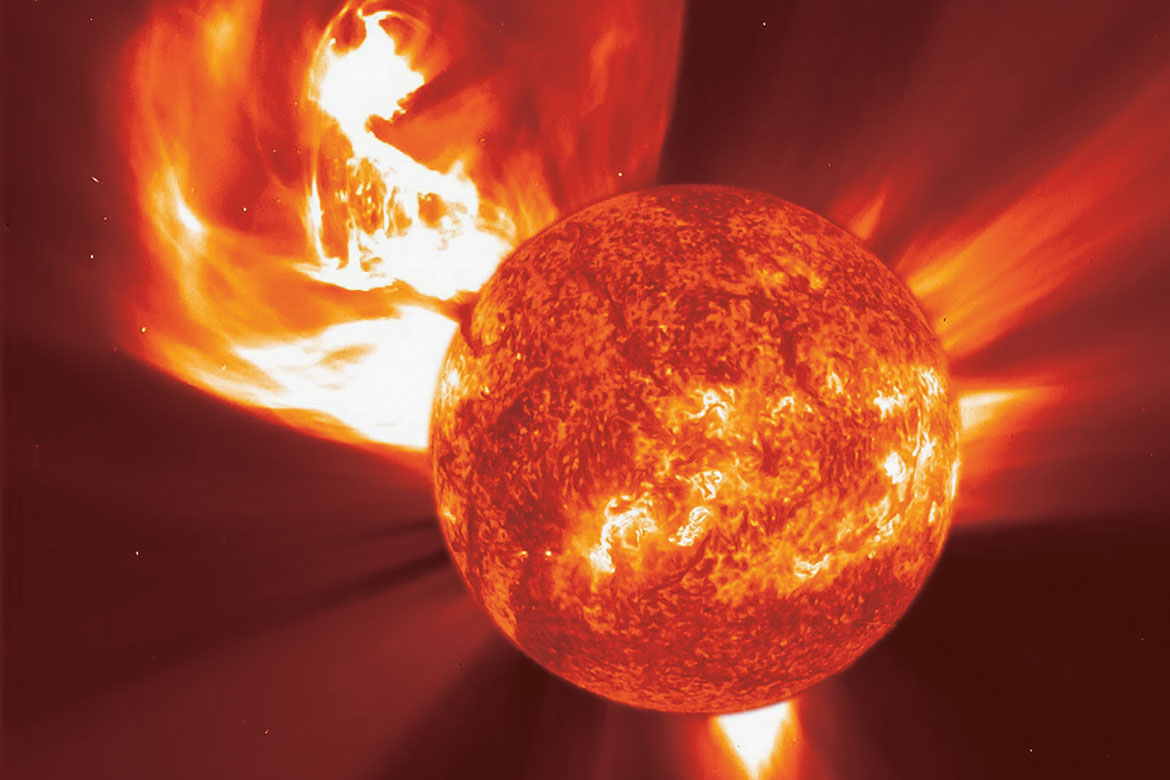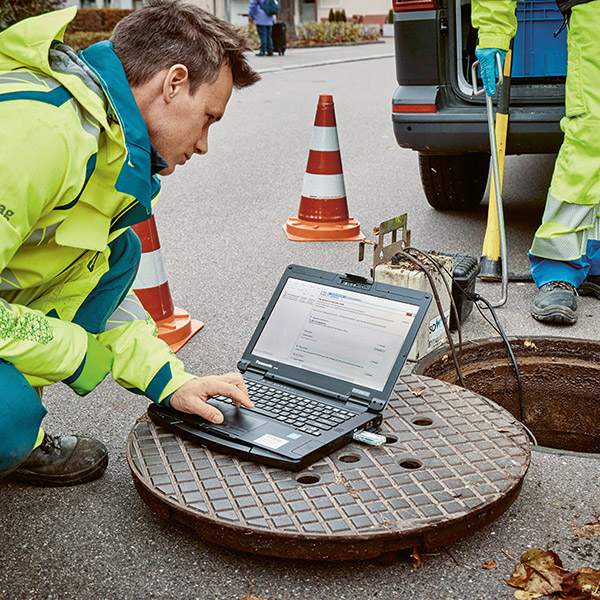ASTROPHYSICS
Gazing into the heart of solar flares
The Sun has not yet finished revealing all its secrets. Recent missions using Swiss technology are providing new insights into powerful solar storms.

When there is a coronal mass ejection from the Sun, plasma explodes into space. This can cause the polar lights and damage satellites. | Image: SOHO
So far, the Solar Orbiter probe has circled Venus nine times in order to pick up momentum. This was just what was planned by the European Space Agency (ESA) when it sent its probe off toward the Sun in February 2020. “These manoeuvres are quite tricky”, says Säm Krucker, a heliophysicist at the University of Applied Sciences Northwestern Switzerland (FHNW). The probe gets rather close to the surface of Venus – just 550 kilometres away – so it can use its gravitational field to accelerate towards its actual target. “In such a phase, any mistake could cause us to lose the Orbiter”, says Krucker.
This latest solar mission is the result of immense efforts, and the hopes of the researchers involved are even greater. The behaviour of our mother star remains mysterious, despite the hundreds of years during which humans have tried to understand it. For example, it is still not known why solar activity varies over an 11-year cycle. Or why the temperature on the surface of the Sun is 6,000 degrees Celsius, but can sometimes reach millions of degrees further out in the corona.
After a two-year flight clocking up billions of kilometres of space, the Solar Orbiter is currently swinging into orbit at a distance of 42 million kilometres from the Sun. That is a little less than a third of the distance between the Sun and the Earth. On board this CHF 1.4 billion spacecraft are ten measuring instruments, including the Swiss X-ray telescope ‘Stix’, designed at FHNW. “ESA has been planning this mission for 20 years”, says Krucker. “Ten years of my life have also gone into it”.
Detectors behind massive heat shields
For many researchers, the Solar Orbiter’s huge mission is of far more than merely personal significance. It will see the poles of the Sun for the first time in 2025. Since it will also be able to see the Sun from behind, it will be able to complete our current view of it from Earth. “We will finally get a real, three-dimensional image of the Sun – not just projections from Earth such as we have had until now”, says Krucker.
Two years before the Solar Orbiter, the American space agency NASA launched another major mission to the Sun. The Parker Solar Probe will venture as close as 6.2 million km from it. It has heat plates to protect it against the heliosphere, where the temperature can reach 1,300 degrees Celsius.
“We are having our cake and eating it”, says Krucker. The Parker Probe will enable researchers to observe solar wind particles at their point of origin, before they fly away from the Sun. However, it is only the Solar Orbiter that will be able to look directly at the Sun and provide a complete picture – albeit from a greater distance.
The timing of the missions has also been chosen well: a new solar cycle began in 2019 and the Sun will become increasingly active in the coming years, peaking in 2025. The Solar Orbiter has ten different instruments on board, and its telescopes can look directly at the Sun through tiny holes in its jet-black heat shield. This means it can take images of the surface and measure particles and fields. “The sun itself is vibrating, too”, says Krucker.
The Sun’s seismic waves will also allow us to see inside the star, whose structure has still not yet been fully explained. A measuring instrument built by the Max Planck Institute for Solar System Research in Göttingen will provide new data for the field of helioseismology, which has recently gained in importance but has so far had to rely solely on telescopes close to Earth. “You can compare this discipline with investigating a musical instrument”, says Gaël Buldgen from the University of Geneva. “It is possible to reconstruct the size, shape and structure of a musical instrument by analysing all the frequencies and amplitudes contained in the sounds it emits. Probing the internal structure of the Sun is therefore like listening to its music”.
The researchers are expecting a “confusingly complex score”, says Buldgen. They know there has to be an error in their models’ assumptions about the chemical composition of the Sun. So their goal is also to develop a new solar model. The current standard models date from the 1980s and are “too vague”, says Buldgen. They want to find out, for example, the extent to which high-energy X-rays interact with solar matter in the Sun’s deeper layers.
Magnetic fields ignite “bonfires”
The researchers also know too little about the magnetic field of the Sun and the dynamic changes it undergoes inside the star. Massive, complex, twisted, tangled fields arise in the Sun due to its rotations. If magnetic field lines break off due to the dynamics and then reassemble, this releases enormous energies.
Improving our understanding of the Sun’s magnetic field is therefore the main goal of these missions. “This magnetic field is the king of the solar atmosphere”, says Krucker. “It determines what happens there”. The X-ray telescope developed by FHNW will play a key role in all this, because it is in the X-ray range that we can best identify highly accelerated, high-energy particles that are linked to strong magnetic fields. “Stix is the only instrument that can measure the energy of these particles during a solar flare”, says Krucker. For example, it can produce images of the hottest region of a solar flare, where the temperature can reach up to 40 million degrees Celsius.
The Orbiter’s measuring instruments have already recorded three thousand such flares during its approach. “Now, for the first time, we can see into the heart of a solar flare”, says Krucker. These flares can also be observed using telescopes on Earth. But thanks to the additional perspective provided by Stix, the arcs typical of a solar flare can now be reconstructed as a 3D image.
By June 2020, the Orbiter had flown to a halfway point between the Earth and the Sun, and had provided images of tiny, enigmatic ‘bonfires’ in the solar corona. These are parts of solar flares that cannot be seen from Earth, and whose appearance might possibly explain the high temperatures that occur in the outer regions of the corona. Unlike the hotplate of an electric stove, for example, the corona heats up locally when magnetic field lines rupture and cause a sudden release of energy.
Researchers are already benefitting from this new, more precise data. They include Lucia Kleint, an astrophysicist at the University of Geneva. She was previously a member of the Stix team at FHNW, where she was responsible for its flight software. Getting precise physical information about the state of the Sun before, during and after an eruption is important for her models. She needs this information across as many ranges of light as possible, from ultraviolet to infrared. “This enables us to capture different layers of the Sun and to create a kind of 3D model of the solar atmosphere”, she says.
Kleint wants to be able to predict solar flares. Extreme events involving billions of tonnes of matter and electromagnetically charged particles being hurled into space could endanger astronauts on space stations, paralyse technological space infrastructure such as satellites, and even cripple sensitive power grids on Earth. “Solar flares are the most energy-rich events in the entire solar system. In the space of just a few minutes, they release an unimaginable amount of energy, comparable to that of millions of atom bombs”, says Kleint. Elsewhere sun-like stars exist whose eruptions are thousands of times bigger than those of our Sun, and astrophysicists still don’t know why. “Will our Sun ever have a flare of such magnitude that it could pose a danger to the Earth?”, Kleint asks.
Kleint is currently using machine-learning methods to process the enormous amounts of data now being delivered. She wants to examine thousands of eruptions statistically in order to determine the general principles that apply to them: “We want to include as much data as possible in our calculations”.
Every week, the Solar Orbiter is sending terabytes of precise observational data to Earth, along with its flight data and information on other parameters. “I look at it all every morning”, says Krucker, “just to make sure that everything is still in order”.




